January 2015 – Our sailing cruise in Mexico introduced us to many wonderful people, and while we were traveling inland to visit the colorful city of Guanajuato, I had a chance to spend some time with my lifelong idol and mentor-in-spirit, figure skater Toller Cranston, at his amazing home in San Miguel de Allende.
This post is a departure from the normal fare found on this blog. However, it is a post I’ve wanted to write for a long time. I just couldn’t find the words. The shock of Toller Cranston’s death over this past weekend opened a floodgate of emotions for me when I learned about it yesterday, and suddenly the words were there. So here it is.

A street in San Miguel de Allende, Mexico, Toller Cranston’s home for two decades

A street musician in San Miguel de Allende
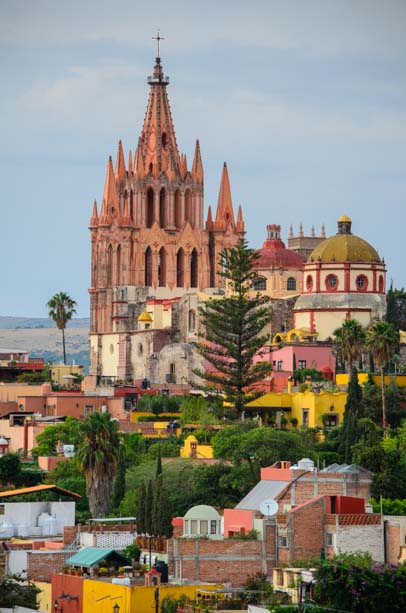
San Miguel de Allende Cathedral — La Parroquia

Flowers and window boxes on a house in San Miguel de Allende
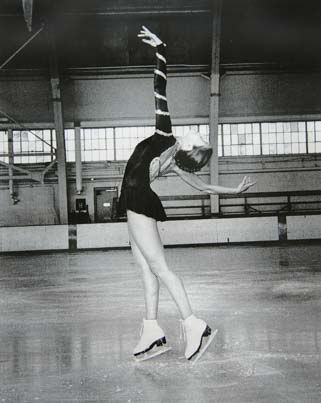
I spent my childhood and youth on the ice.
As a child and young teenager, figure skating dominated my life, and I competed at a high level. At the time, spending six to seven hours a day on the ice seemed perfectly normal, because all my skating friends and rivals were doing the same thing. You couldn’t stay competitive with anything less.
It was only decades later that I realized that from age 13 to 16 I had put in over 40 hours a week learning to master the ice, to skate with abandon and grace, and to perform. It was a huge effort, but I loved it. I treasured every minute of being a skater, especially when an unusual Canadian skater, Toller Cranston, showed up in the world class competitions and opened my eyes to the vast potential of the sport.
Competitive skating is very conservative and is largely made up of cute little girls in pink dresses and the dour middle aged judges in heavy coats and sweaters who rank them.
Skaters pay their coaches big bucks to help them determine exactly what the judges want to see and then learn how to do it. The judges are not paid for their time but are reimbursed their expenses, and the skating we see on TV is a perfect reflection of what they have rewarded throughout skating’s ranks with good marks on their score sheets.

A little skater shows me her medals.
I was like this nearly 50 years ago too!
If the judges want jumps with tight rotations, the skaters deliver. If it’s dizzying spins with many changes of position, they’ve got it. Fancy footwork — done.
Skaters learn very young not to let a single hair be out of place, and by age 12 the most elite among them are seasoned “professionals” that are well accustomed to being stars, signing autographs, dealing with fans, and receiving ovations.
Figure skating as an institution is slow to change, and it’s a world that is highly averse to rebellion. The judges can squelch any renegade with the flick of a pen. And they do.
So it was with total shock that this insular community witnessed Toller Cranston coming into his own in the mid-1970’s. He took on the Establishment in ways that the Hippies, who talked of such things, couldn’t possibly imagine. Brash, bold, outspoken and charismatic, Toller introduced drama and passion into skating to a degree that had never been seen before.

The judges call all the shots in skating. I was a judge at one time!
I was mesmerized. On the cusp of adulthood myself, I watched this man in awe as he battled for all he was worth to show the world his vision of what skating could be. He did moves no man had ever done, and no man would dream of doing at the time. Prancing on his toes, swooping his body into wildly rounded and angular shapes, and leaping into the air with total glee and nary a rotation, he was exotic, exciting, thrilling.
I don’t have any pics of Toller skating, but there are two wonderful pics here and here.
Competitive skating is a tiny world too, one where skaters know and “know of” each other even if they haven’t met. When my own skating career came to a screeching halt after I developed spondylolisthesis (probably from too many double axel attempts), Toller wrote me a letter of encouragement and sympathy.
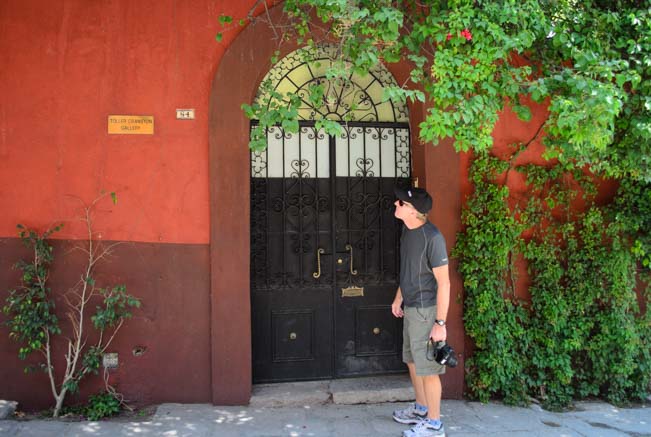
We arrive at Toller Cranston’s imposing front gate.
At the time, he had started “The Ice Show,” a fabulous new style of skating entertainment, and in his unique hand-written scrawl, he said he wished I could have been part of the group. I was blown away, unbelievably touched and absolutely crushed at the same time. I was 17 by now, and living away from home in a new life at a unique high school trying to come to grips with giving up skating. If I could have, I would have run away to be a part of anything he was doing in a heartbeat.
That thoughtful letter and those few words have stayed with me throughout my life.
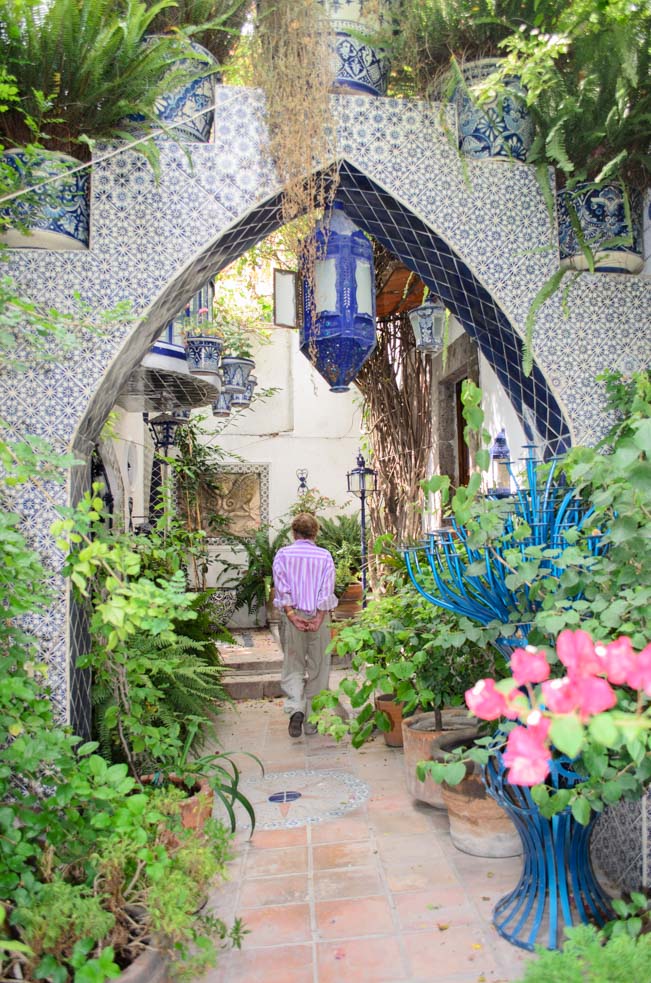
We follow Toller through his garden
Toller went on to take on far bigger worlds beyond skating, and I lost track of his many projects.
But the essence of what he did on the ice — his fearless pursuit of his passion, his daring moves that flew in the face of everything the skating world held dear, his steadfast commitment to doing what he believed in, and his utter whimsy and charm — continue stay with me to this day.
I’ve always wanted to live my life with a fervor and soul that is just as deep and just as free.
While our sailboat Groovy was anchored in Zihuatanejo, I became friends with Pamela Bendall who, at 57, was completing a 5-year solo voyage from Vancouver to Peru and back aboard her 47′ steel yacht, Precious Metal.
I discovered she was an Olympic alternate gymnast for Canada in the early 1970’s. We had a rare connection with each other as two women who had spent their girlhoods training to become top athletes, dreaming of perfectly executed tricks and polished performances under pressure.
As we sat on the bow of her boat eating potato chips together (an absolute no-no in our past lives), I casually mentioned that her countryman Toller Cranston had been my idol. What a surprise it was to find out that she grew up in the same town as he did.
“You know, he lives in San Miguel de Allende here in Mexico now,” she suddenly said.
Where? I’d never heard of the place. I made a mental note, but thought nothing of it since it was nowhere near the coast. A year later, however, Mark and I found ourselves exploring Guanajuato, just an hour away.

Former gymnast Pamela Bendall aboard her cruising sailboat Precious Metal
I checked the internet to see if Toller’s address might be somewhere online and discovered he had his house for sale. When we rang the doorbell at his estate’s imposing gate a few days later, a maid gave me a slip of paper to write my name on so she could give it to him before letting me in.
Then, suddenly, there he was at the gate, his hair slightly disheveled and his pants spattered with paint. We exchanged greetings, and he gestured for us to follow him. I asked if he remembered me. He turned back, with a theatrical swoosh, and looked at me pointedly. “I know all about you!” he said.
Mark was totally impressed, but I know drama when I see it, and this was obviously mostly for effect — and the effect was awesome.
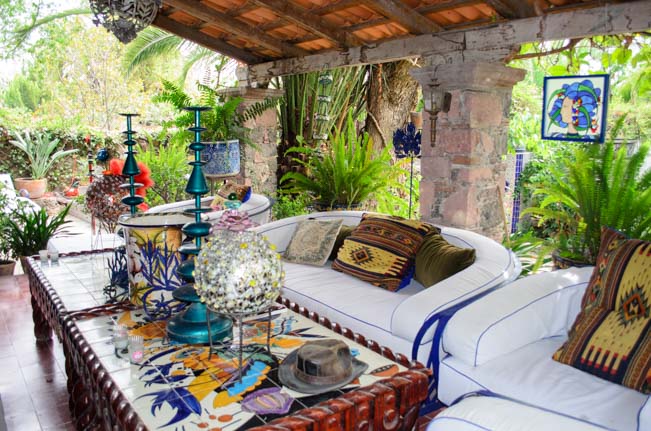
Wonderful outdoor seating by the garden.
We followed him through a lush garden that was utterly overgrown and stuffed to the gills with outdoor art pieces. Once inside his home, we discovered we had arrived right in time for a big Sunday brunch he was hosting, and his guests began arriving. He invited us to stay and have brunch too, and in no time a large circular table was packed with about 10 guests.
We found ourselves in impressive company, including Nat King Cole’s daughter and the parents of a halfpipe snowboarding Olympian. Mark and I were speechless listening to a fast repartee between everyone about art, art collections, art collectors, art history, and other highbrow things we know little about.
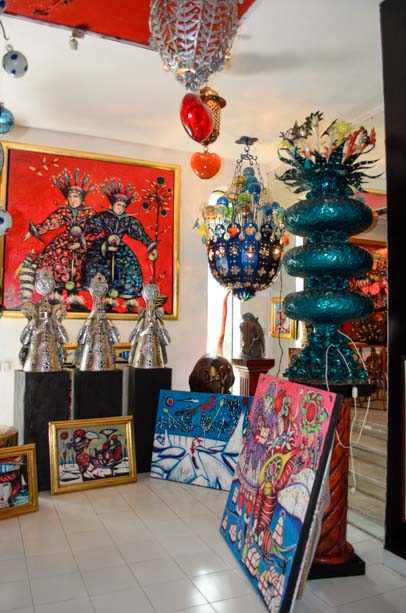
There were paintings and artwork everywhere.
Suddenly, Toller announced to the table in a loud voice, “You know, Emily and I have a past…”
I froze as everyone turned to look at me.
“A skating past,” he went on with a sly smile.
I loved his sense of timing and flare — it was impeccable, even here at the breakfast table.
The conversation turned to skating, and more lightning quick conversation sailed over my head as they discussed skating champions of the last two decades that I don’t really know.
I stopped watching TV regularly in 1994, and have managed to catch only a rare glimpse of one skater or another since then, if I happened to be in a place with a TV when a skating event was on.
But when they turned back to discussing the skating greats of the 1970’s, I was right there with them, reminiscing about Janet Lynn‘s charm and John Misha Petkevich‘s soaring jumps.
Eventually, the brunch guests left, but Toller invited us to tour his estate and stick around a while.
He has made his living as an artist since his early teenage years when he attended art school, and every corner of his mansion was crammed with artwork, both his own and others’.
Our conversation turned to skating again, in bits and spurts of questions and answers, and slowly the quest I had been after when I first decided to knock on his door in San Miguel de Allende began to be answered.
Who was this unusual artist? How did he dare to be so free? What made him tick? What did he think about all day? And where had life taken him since he stood on the podium at the Olympics?

Every seat in the house was surrounded by art.
In a few short hours that day and the next, a heavy cloak of sadness slowly wrapped itself around my heart as I listened — between the words — to what it took for this man to change the direction of the institution of men’s figure skating.
Toller came into skating at a time when all the flamboyant beauty of free skating counted for only 40% of the overall score. The other 60% of the score came from circular etchings on the ice called “figures” (and which took 75% of my practice time and every one else’s).

Toller collected the pottery work of local artisans in Mexico
Wild passion and figures don’t mix well. Even worse, figures can’t be seen by anyone but the judges who walk around on them in rubber boots after the skater is done, as they study each tracing and take notes on a clipboard.
Toller developed a reputation for being “bad at figures,” although no one but he and his coach and the judges who saw them will ever know for sure. At the same time, he was up against a rival from England, John Curry, who, like him, sought to do more with free skating than merely jump and spin.
Rivalries drive us all to exceed our highest expectations, and the rivalry between these two men was a thrill to watch. John Curry was the ultimate technician, completing each trick with textbook precision, dead-pan expression, and exquisite grace. Toller Cranston was pure emotion in action, effortlessly grabbing the hearts of those who watched him. With every move in his many performances, he held a gasping audience in the palm of his hand.

Artwork, artwork everywhere!
In the end, John Curry took all the big trophies and Toller was lucky to get third spot on any major podium, something I didn’t remember at all until he shared his memories with me. To my surprise, regret hung heavy in the air around us as he talked about his past.
He recalled with horror how the first figure in the Olympics was a right forward outside rocker, a beautiful figure that involves two very cool twisting turns that tie three circles together. Bad luck struck as he pushed off on the first half circle. His eyes filled with tears and he couldn’t see a thing.
That’s like totaling your car on the first half lap of the Indy 500.
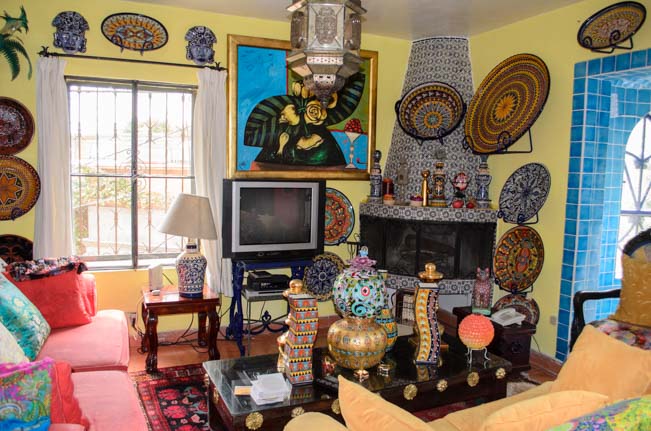
Every wall and surface held artwork
He had other tales of torment at the hands of ruthless, narrow minded judges, some of whom had judged me too. He wore a wry smile as he talked of a former skating star from the 1950’s who had visited him in San Miguel and had become openly emotional as he apologized for zealously and publicly slamming Toller’s skating vision and style when he was at his peak.
But did Toller know how much he was loved by his fans? I wondered.
Our conversation, which was really just stutters of comments thrown to the wind towards each other, turned to his art. We were flying through his mansion on this crazy whirlwind tour as we talked, seeing room after room after room. Huge canvasses and sculptures and unique decorations were everywhere.

Mark and I pause our tour of the art-filled estate to chat with Toller a bit.
We sat down in his living room to talk a little more in depth, and vignettes of his past gradually took shape before us as he talked.
“I paid for all my skating myself with my art.” He suddenly blurted.
My jaw dropped. That is unheard of. Not only is it nearly impossible to make a living from fine art, but Toller had done so as a young art school student, and he had funded an extraordinarily expensive skating career in the process.
What’s even more amazing is that, generally, every elite figure skater is sponsored. Even I had a sponsor, I told him, or I would have had to quit at age 12. His expression was haunted as he said, “No one ever sponsored me. I paid for it all myself.”
My respect for this man shot up a thousandfold.
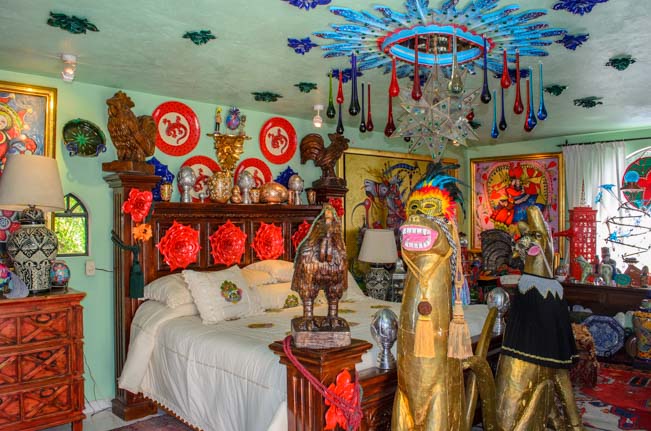
As the hours passed, we resumed wandering through his many bedrooms, through the corners of his home where he liked to read and watch TV, and into his brilliantly lit studio that was lined from floor to ceiling with windows. My emotions became a blur of confusion as I listened to him and took in his life experiences and overlaid them on my own.
“The world only remembers the winners,” he said grimly at one point. “They only remember the names of the champions.”
I was completely taken aback. Didn’t he realize that he had single-handedly changed men’s figure skating forever, regardless of whether his name was etched on an Olympic trophy? Didn’t he know that the people who change the course of history are the ones that are remembered?
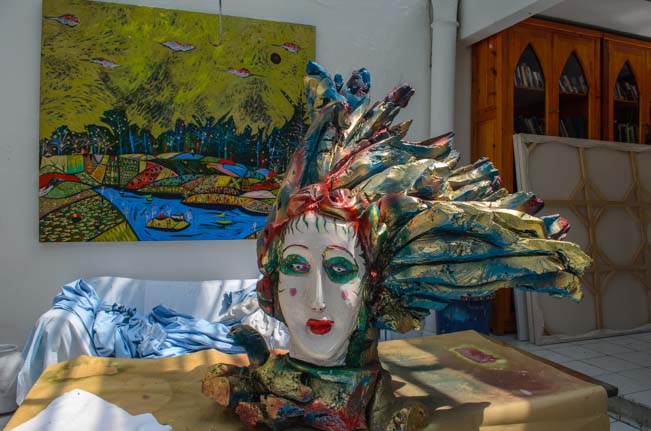
A sculpture he was working on.
We were walking through his past, and my past with it, and there was so much I wanted to say and to share, but the words just weren’t there, and I’m not sure he would have listened anyway. I was elated to have a chance to be with him at last, but so frustrated for not having more time and more peace.
The household was abuzz all day long. Maids and neighbors wandered in and out at will, art students and art assistants zoomed by us repeatedly, intent on their missions in and around the estate. I marveled that Toller could think straight in all this chaos. Perhaps he thrived on it, but I wasn’t sure.
He was intrigued by our travels and asked us a lot of questions about the places we’d been and where we were going next. At the time, Mark and I were wrapping up our sailing cruise, a nearly four year voyage that had opened our lives up in ways we never dreamed of.

We see room after room of fantasy artwork and even some elaborately decorated eggs.
We were just months from moving off our boat permanently and putting it up for sale. As we filed away precious memories of our voyage, we knew we were embarking on an exhilarating new phase of life as bigger, stronger and more experienced people.
Why had we started traveling full-time six years prior? Toller wanted to know. To change our lives and have an adventure was my quick reply.
“I need to change my life too,” he said wistfully. “I want to have an adventure.” He sounded eager. He talked of wanting to sell his estate and buy land nearby to build a new home.
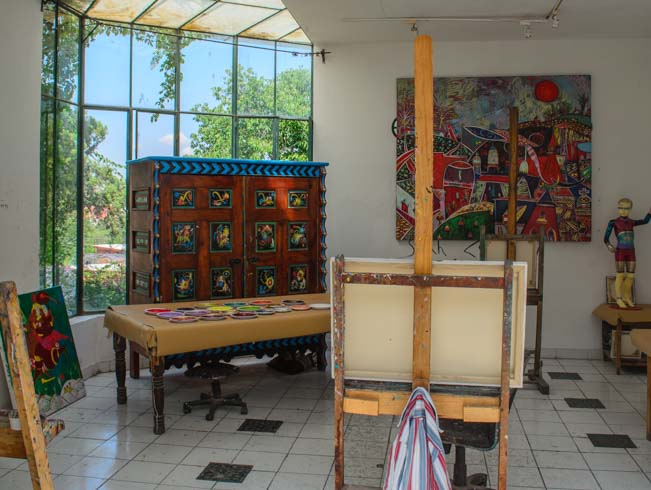
Works in progress in the studio
Eventually he bade us goodbye from somewhere in the middle of the mansion, and we left his home on our own, wandering through the maze of gardens in a stunned stupor, and making several wrong turns in the process. The encounter stayed with me for weeks as we prepared our boat for its final 1,000 mile journey, the Baja Bash from Puerto Vallarta to San Diego.
I couldn’t help but feel that the cost of being a maverick, of striking out against tradition to do something bigger and better and more exotic than the norm, had been very high for him. Because of the sport’s rules in place at the time, and his fierce determination to pursue his own vision, Toller was never rewarded with the most important gold medals that are the badge of success and acceptance in sport.
Nevermind that many of the moves we see skaters doing today were his inventions. That doesn’t doesn’t put your name on the roster of history’s World Champions.

Glass doors to the garden from the studio
Yet, at the same time, I was bemused that a free spirit who turned his back on convention would have the slightest interest in being rewarded conventionally. Would the accolades of the Establishment, of judges who couldn’t see or accept his brilliance, really have meant something to him? Sadly, the pain of his losses in the highest levels of competition seemed as raw and as fresh to him now, in 2013, as they had been in the mid-1970’s.
It was agonizing to see that a man who had so bravely followed his own heart didn’t find the fulfillment of his vision to be satisfaction enough in itself, without the approval of the very people he scorned. I realized later that I had wanted my hero to have believed in his dream at all costs, no matter what, because heroes are larger than life and they don’t fall prey to the mortal foibles of things like wanting to be accepted and approved.

Elaborate glasswork decorated many charming corners of the garden.
Two days ago, we got the news that Toller died unexpectedly of a heart attack, at age 65, in his home in San Miguel de Allende, Mexico. I was devastated. Of course, his timing was spot on once again. He died on the day of the men’s competition at the Canadian National Championships, which was also the rest day between two riveting performances by Jason Brown (who seems, for all the world, to be channeling Toller’s essence) at the men’s competition at the US National Championships.
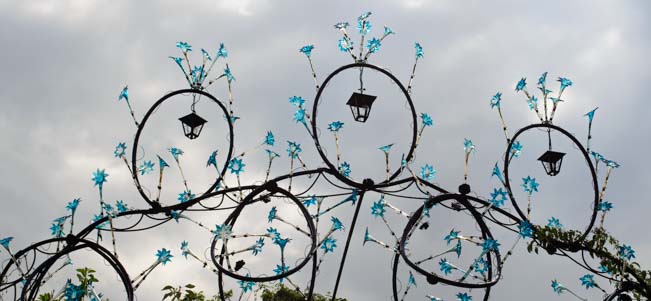
Glass ornaments form an arch over the garden.
In pondering Toller’s life and death, I kept thinking of Steve Jobs’ quote about how we all have nothing to fear because we are already naked. I looked it up, and found it comes from the commencement speech he gave at Stanford in June, 2005, shortly after he learned he had pancreatic cancer:
Remembering that I’ll be dead soon is the most important tool I’ve ever encountered to help me make the big choices in life. Because almost everything — all external expectations, all pride, all fear of embarrassment or failure – these things just fall away in the face of death, leaving only what is truly important. Remembering that you are going to die is the best way I know to avoid the trap of thinking you have something to lose. You are already naked. There is no reason not to follow your heart.

Paints and paint brushes ready for use on an egg decorating project.
I don’t think that when Toller opened his day planner for the week of January 18th, 2015, he skipped down to Saturday, January 24th, and penciled in “Exit This World.” But that is what happened. And I couldn’t help but think:
If you are nurturing a dream — to break whatever bonds hold you, to get a boat and go sailing, or to run off in an RV and explore for a while — go for it. You have nothing to lose, except time. Your dream is yours, and yours alone, no matter who applauds or condemns the idea. Give it wings with your own faith.

We share a past…
After we got the sad news about Toller’s death, we went out to do some errands. As I climbed into the truck and turned on the radio, my thoughts couldn’t leave Toller’s lively breakfast table in his home, his crazy art-filled estate, and his darkness as bits and pieces of the stories from his past escaped his lips, soaked in bitterness.
Suddenly the radio erupted with the bright, energetic sounds of Leonard Bernstein’s Candide Overture, the music I had skated to when Toller had had his greatest influence on me. It was the music that had carried me to Nationals forty years ago.
I sat back in shock. What a coincidence! I rarely hear that music on the radio. As my soul followed the high spirits of the piece, I felt chills running up and down my spine. I was covered in goose bumps. Without warning, tears suddenly began to stream down my face and I dropped my head in my hands.
I didn’t have a coherent thought in my mind, and I was overcome as I cried openly and the tears flowed freely down my cheeks. This music, thoughts of my mentor-in-sprit, Toller, and memories of that visit to his home that I been so fortunate to share with Mark all swirled around me in an overwhelming vortex.
In that moment, I have no doubt that Toller was reaching out to touch me — as he swung by on his way out.
Some clips from YouTube —
“Totally Toller” —
“I Pagliacci” (No one skated to Opera back then… good heavens!) —
Related Posts:
- What is Your Dream?
- Ice Queens of Sun Valley, Idaho – Summer Skating Competitions
- Guanajuato, Mexico – Colorful hillsides of stairs, tunnels and a rich history
- Guanajuato, Mexico – Full of Song and Spirit
Although I wrote this post in January, 2015, it fits into our June 2013 travels right between our visit to Guanajuato, Mexico, and our stay at Casa Maguey on Mexico’s Costalegre.
<-Previous || Next->
New to this site? Visit our Home page to read more about our full-time traveling lifestyle and our Intro for RVers to find out where we keep all the good stuff. If you like what you see, we'd love for you to subscribe to receive our latest posts!

What an amazing story about an amazing and creative guy. You can see the passion he had in his art work, even if (like me) you know very little about figure skating. Also fascinated to hear your history in the sport. I had no idea. Really enjoyed the post!
Nina
I’m so glad you enjoyed this post, Nina. I am hoping people from all walks of life, not just skaters, find some inspiration here, and perhaps even some cause for introspection. Skating and painting are but two of so many art forms, and in some ways the greatest of all the modes of artistic expression is the way we each choose to live our lives. Finding someone like Toller who has lived entirely outside the box is cause for celebration as well as sadness at his passing.
Very moving well written story. Love your Quote about nurturing a dream, a good one to live by. Would like to use it if you don’t mind. Take care, cheers.
I’m tickled you liked that quote, Bill. I was surprised and pleased when I came up with it (divine intervention!)!! I don’t mind if you use it…and I don’t mind if you say where it came from too (smile) !!
After 2 years on the road in a 26 foot fifth wheel, my husband and I discovered your WEB site in 2013. I have never written until now even through I have relished your postings and photos. Wild and free, outrageous and transcendent this friend of yours. An unexpected inspiration on this day when I just finished a painting of lush red and blue Mexican bananas. They seem fitting for Toller’s and your story. His Utube video and your photos of his home make me want push the envelope while I can. Thanks
The lush red and blue bananas sound wonderful — what a perfect painting to go along with this story. Thank you for letting me know you were moved by this post. And please do push the envelope while you can — we all need to do more of that, and we will all inspire each other as we do!!!
I know it’s just a cliche, but I am speechless. Your post is SO well written that I feel I was right there with you. He was obviously a special person in your life that maybe even you were not fully aware of. He was wrong about needing to be a Champion in order to be remembered. I for one remember him and his skating. I know NOTHING about figure skating, but I remember how he was different, a standout among his peers. A joy to watch. Thank you for bringing your visit with him and his home to us…and your memories.
Cliches are fine, Ed!! But speechless is truly touching. Thank you! And how happy I am that you and other readers remember Toller’s beautiful skating and how he stood out from the crowd. I am so glad I could bring you along — in spirit — on our visit to his home.
What a delightfully engaging account of a unique experience! Thanks for sharing these intimate moments with all of us. Yes, this is a bit removed from the areas of activity that you usually cover, but this sort of writing adds a richness to the blog that is one of the reasons it stands so clearly above many others. Bravo, Maestra!
Wow!!! Thank you so much, Dan!! I really really appreciate your thoughtful and kind words! It is definitely unnerving to “bare all” on the internet, but this story is very precious to me, and I felt it needed to be told, especially now that Toller’s genius will no longer expand with new works in our realm. And I agree, it is wonderful to flush out any blog with personal bits and pieces that reveal something of the person behind it. Thank you so much for expressing such praise — I’m blushing, but it feels really good!!
A very touching post Emily. I love to watch figure skating but I know little of the background of the skaters and had no idea you had history with this sport. Thank you for sharing! It was also lovely to revisit San Miguel through your eyes.
San Miguel is indeed a lovely place, and I’m glad my few pics brought back some memories for you, LuAnn. It was not as lively or vivacious as nearby Guanajuato, and I was very surprised Toller chose to live there rather than in its more theatrical, colorful and vibrant neighbor city, but it is elegant in a subdued way. Thank you for letting me know you were touched by my writing. It is wonderful to find fellow skating fans in the RVing community!
I was really touched by your article and memories of Toller Cranston. Unfortunately, I never got a chance to meet him but did see him once at a restaurant in San Miguel last year having breakfast with friends. I only discovered his identity after we moved to San Miguel three weeks before his death. There was something about his style of dress and demeanor that made me think he was “someone of interest” here in town. I have since been told that he would have loved to have known that he made that impression! Since his estate was finally settled recently, a large estate sale of his belongings was held at his home in San Miguel. I was fortunate to be able to attend the sale on several visits and wander from room to room imagining what his days were like in that incredible house, chock full of color and art. I was able to purchase a number of items (mostly Talavera pottery pieces, of which there were hundreds, as you will remember from your visit). Even though I had never met Toller I felt that I wanted to have something of his to remember him by as he was such a well-known and loved personality here in San Miguel and pieces of his colorful and imaginative art are found all over town. Your article was full of insight into Toller’s impressive and rather poignant past. Thank you for giving us your impressions of his life as an artist, both on the ice and on canvas. Since living in San Miguel for the last nine months, I can see why Toller chose this place to live. He apparently loved it! Like Guanajuato, it is a lively, vibrant town, full of festivities, fireworks, parades, church bells, and cultural events. I can see why at times there might be an impression of it being a quiet, subdued, and elegant place. It is all that, at times! There is an ebb and flow of quiet times and times of noise and craziness. That is why we love San Miguel! Come back sometime and visit! Laurie
Wow, Laurie, thank you so much for sharing your story. I am touched! Toller was larger than life in so many ways, and it makes me smile that simply his essence and aura within the community of San Miguel moved you to purchase a piece from his pottery collection to remember him by. I’m sorry you didn’t have a chance to get to know him. I still catch myself thinking of him sometimes and marveling that he is no longer with us. It just doesn’t seem possible. You are fortunate to live in San Miguel, and how wonderful it is to hear that there are pieces of Toller’s art work around town. I’m sure he is sorely missed by everyone who knew him — and by those who didn’t as well! We do look forward to returning to San Miguel someday. Sadly, it will be beautiful but very bitter sweet too…
Envious I am of the eloquent accolades written above. I’m in awe of your ability to express your thoughts and to convey the essence of someone justifiably admired. I remember relishing Toller’s performances on television back in his day, and thinking at the time that the man was not properly rewarded for his skill nor his artistry. To this day, watching and admiring various figure skating artists is a favored pastime. Thank you for brightening my day, though It came with a flood of tears at the conclusion.
Thank YOU so much for reading and remembering and sharing your thoughts, Don. Sadly, I still have an “Oh wait, he’s gone…” kind of moment every time I think of Toller’s genius and remember he’s not with us any more.
How very kind of you to share such a lovely story of you’re visit with Toller Cranston. I was, and still am, very much a fan of this amazing athlete and artist. Thank you for the deep dedication to your chosen sport and for sharing your skills with us … what an encouragement each of you are … amazing humans to me !
Oh my, Jayne. Thank you very much! Figure skating is a beautiful sport and art, and the people who love watching it, whether or not they lace up their own skates and take to the ice themselves, are the ones whose passion ensures it continues to advance to greater and greater heights. I am still shocked that Toller is gone, and it is wonderful to know that others feel the same way. Thank you very much for appreciating this article and for leaving a comment here.
Thank you for sharing your skating history and your visit with Toller. I lived in Baie D’Urfe in the 1960s and 70s and skated with him at the time in our holiday skating pageants as a little kid. He was probably a late teen, early 20s and the town hero and holding his hand and gliding out on the ice with him was thrilling. We also attended the same high school. My mother adored him and we followed his career and path in life through the decades. We live in San Miguel now, a place I first learned about through him in magazine articles. I had always wanted to visit him here and your story about your visit and skating history with him made me feel what that visit would’ve been like. His house has been torn down and his art can still be seen in homes here and we live next door to his once long time neighbor here. His memory lives on.
Wow, Tonya, I’m so glad you found this page and that you wrote about your experiences with Toller. How fortunate you were to know him as his skating was blossoming and his career was on the rise! What a time that must have been. A lot of people must have had an inkling he was going places and might even change the sport. And lucky you to skate with him in those holiday pageants! How exciting to hold his hand and glide across the ice together. Such memories you must have!
San Miguel is a wonderful town, and you must love living there. We were at a local swap meet in Arizona a few years back and saw a ceramic tile painting for sale that made us both stop dead in our tracks — it was the cathedral in San Miguel and we both recognized it immediately! We promptly bought it and then studied our photos of the church and realized it showed the opposite side of the cathedral as seen from roads we hadn’t been on since we never went over to that side.
I can’t believe Toller’s house was torn down. What a loss!! I didn’t think any of those old historic buildings in San Miguel (or any of Mexico’s colonial cities) were ever torn down!! I’m sure he still has many friends all around town who cherish his paintings on their walls and miss his presence very much.
Enjoy your life in Mexico. We really miss our lives there. And thanks again for leaving your comment!